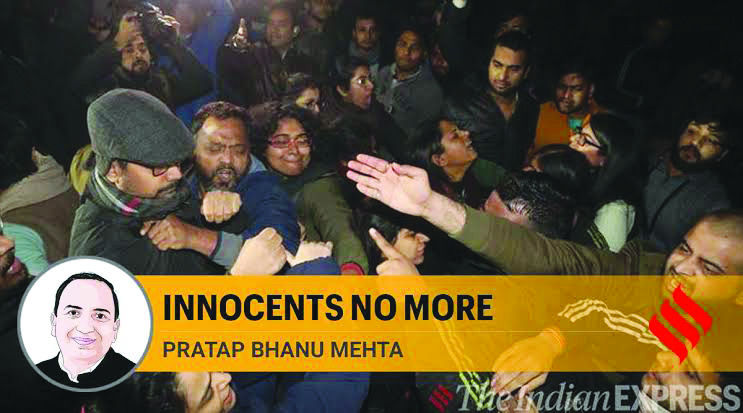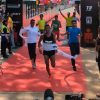Goa is abuzz with excitement as vintage bike and car owners, users, collectors and fans are decking […]

JNU ABVP VANDALS TARGET HEART OF INDIA!!
Jan 11 - Jan 17 2020, Stray Thoughts January 10, 2020COLLUSION: The police instead of arresting the ABVP goons escorted them out of the campus as though they were VIPs.
BY RAJAN NARAYAN
AND a few stray thoughts for yet another Saturday. For a Saturday following the week when despite the intervention of Governor Satyapal Malik, the Centre ignored Goa’s protests against the diversion of Mhadei river waters. For a Saturday following the week when a special session of the Goa Legislative Assembly was held to endorse the Central bill extending reservations to schedule castes and tribes in Parliament and State Assemblies for the next ten years. For a Saturday following the week when alumni of JNU in Goa joined the protest against the bashing up of students and professors allegedly by ABVP goons. For a Saturday following the week when the Supreme Court undermined the autonomy of aided minority educational institutions by reserving the right to make appointments.
RESOLUTION ON MHADEI
And a few stray thoughts on the entire opposition came together to pass a unanimous resolution against the diversion of the Mhadei river to Karnataka. This despite the fact that even Governor Satyapal Malik, the controversial former director of Jammu & Kashmir speaking to the Prime Minister Narendra Modi about the Centre’s bias against Goa. The levels of water in various dams and reservoirs has already come down because of the Mhadei river diversion following the construction of the Kalsa Bandara dam near Belagavi. The Mhadei river is the lifeline of Goa and is the main source of water supply to the Mandovi River and more specifically Opa drinking water pumping plant.
If the Mandovi dries up forget about transport of barges, even ferries won’t be able to cross the various rivers in the State. The worst affected will be the off shore casinos which fetch the government so much revenue. If mining revives Goa will be at a serious disadvantage as the water transport which was the backbone of the mining industry may not be available. The mining industry was viable in Goa because instead of using road transport, the ore extracted from various parts of Goa were taken to the nearest river and transported by water to the Mormugoa Port Trust. The mining industry went one step further and acquired trans-shippers so that ore could be transported from barges directly into the ships from countries which were importing the ore.
DOUBLE DISASTER
When mining stopped it was a double disaster for Goa as not only did the State lose revenue from mining royalty but MPT decided to convert ore loading berths into coal loading berths. The resultant coal pollution since the trucks pass through Vasco city was much higher and this is hazardous to health pollution. Breathing in fine coal dust in the air gets into a delicate respiratory system affecting it, particularly in the case of youngsters.
Mercifully the Supreme Court has passed an order cancelling the original permission to download coal at the MPT.
MASS COAL IMPORTS
Only a very small proportion of the coal imported into Goa is used by local industries. The bulk of the coal imported is for the Jindal Steel and Adani Power plants in neighboring Karnataka. Contrary to the belief that the late Manohar Parrikar defended the interests of Goa, it was he who wrote the first letter defending the right of Karnataka to divert a small quantity of water from Mhadei river to the Malaprabha river basin. Parrikar pointed that the quantity of water that needed to be diverted, if it was for only drinking purposes for Dharwad and Hubli, the quantity required would be much less than even what Karnataka had demanded. Following Parrikar’s death however Goa’s influence at the Centre has been reduced to zero. Nobody has even heard of the current Chief Minister Pramod Sawant who does not command any influence in Delhi.
In sharp contrast Parrikar was considered among the top four leaders of the BJP party and was even spoken about as successor to Narendra Modi if there was a change of leadership. The grim reality is that Karnataka is far more important to the BJP leadership than Goa. It is the only large Southern state which is controlled by the BJP even though Chief Minister Yeddyurappa may be 80 years old.
MINORITY IN RAJYA SABHA
The BJPs main concern is to get at least a simple majority in the Rajya Sabha where now it is in a minority. To get a constitutional amendment bill like the CAA passed it is essential that the concerned bill be passed both in the Lok Sabha and Rajya Sabha. Karnataka has 15 seats in the Rajya Sabha unlike Goa which had only three seats. Of the three seats that Goa has in the Rajya Sabha two are already with the BJP. Goa is of very marginal importance to the BJP compared to Karnataka which is the first southern state that BJP captured.
The BJP is aware that it is not likely to win the polls in Kerala, Andhra Pradesh or Tamil Nadu. If it is a question of Karnataka’s interests and Goa’s interests the former will take priority with the BJP. Governor Satayapal Singh must be commended for taking up Goa’s case on the Mhadei river. But obviously he was told to shut up and he has not mentioned it again. To add insult to injury the combined Opposition resolution on Mhadei diversion was not even permitted for discussion by Speaker of Assembly Rajesh Patnekar.
RESERVATIONS EXTENDED
AND a few stray thoughts on the special 1-day session of the Assembly to extend reservations for schedule caste and tribes for another ten years. When the Constitution was formed in 1950 at the insistence of Dr Ambedkar it was decided that for at least ten years reservations would be created for representation in the Lok Sabha and the Assemblies. The logic was that people from the lower caste never got elected to the Assembly or Parliament as they did not have the resources to fight and win elections. The political parties themselves were dominated by the upper castes. This includes the BJP which is also dominated by upper caste people, except for Narendra Modi not a single member of the backward classes has been prime minister of India. As far as Goa is concerned since the population of ethnic scheduled castes was very low it was decided to choose an Assembly seat by rotation for the scheduled caste.
INDIAN CASTE SYSTEM
Since Goans are not familiar with the concept of scheduled caste it must be clarified that in the rest of the country the varna system divides the people into four categories, namely brahmins, kshatriyas, vaishyas and shudhras. The shudhras were entrusted with the most menial jobs like cleaning toilets or plucking coconuts. In Goa there were no scheduled castes but only scheduled tribes. The only exception is Babu Azgaokar who claims he is from the scheduled caste and won election repeatedly from whichever constituency was designated as a scheduled caste constituency. Which is how Babu who is originally a resident of Margao first contested from Fatorda which has a large ST population and then shifted to Pernem which had an equally large ST population. In constituencies reserved for SC and ST candidates belonging to higher castes could not contest, assuring victory for the likes of Babu Azgaokar.
NO CASTE IN GOA
Unlike in the rest of the country in Goa there were only the bhatkar and under them the tenants who cultivated the fields and the mundkar who were house servants of their bhatkar were given a place to stay on the property. The other prominent community is the Kalvants who were women dedicated to the temples as dancers and singers, but in practice became mistresses of the Bhatkar. It is claimed that the first Chief Minister of Goa Dayananand Bandodkar, not to mention India’s most famous singer Lata Mangeskar, are from the Kalvant community. It is because of the humiliating treatment given to her by the bhatkar of Goa Lata never sings in Goa even though the main Kala Academy auditorium is named after her brother. What Dayanand Bandodkar, Goa’s first chief minister did, was to bring together all the non-Saraswat classes into the Bahujan Samaj which included the Bhandari who were the trading class and the Vani, and the fisher people and even the barbarians.
The only ones left out were the scheduled tribes comprising Gaudi, Velip, Kunbi and Dhangar. Though the Goa government treated the tribals as a special category and gave them reservations, no survey was conducted and they were not included in the Central List of Scheduled Tribes. It was only a decade ago that the Gaudi, the Kunbi and Velip people were included in the Central List of the ST which meant that reservations will be made for even in the elections, let alone admission to colleges and government jobs.
12% ST IN GOA
It is estimated that the population of STs who are the original inhabitants of Goa is roughly 12% though it is probably much higher. By this logic 12% of the seats in the Assembly (four at least) should be reserved for the ST members. This will katurfai Babu Azgaokar who has taken unfair advantage of the reservation for ST. The STs are no longer as backward as they were and many of them are now educated and aware of their political rights. In fact, the STs have become conscious of the fact that much of their land including the land on which Cidade-de-Goa is built originally belongs to them. A former driver of ours from Odxel, Kutikar, managed to win a court case and got his land back and he is driving a luxury car. The period for reservation of seats in the Lok Sabha and the Assemblies for SC and ST has got over. That is why the special bill was passed in the special session to extend the period by another ten years. There are of course arguments that 60 years are more than enough for STs and SCs to become forward. The logic behind the reservations was that the Brahmins and upper castes dominated all political positions and businesses, thus forcing tribals and scheduled castes into manual scavenging.
The reality is that Indian society is still dominated by the upper caste and no conscious attempt is being made to improve the status of the SCs and STs. There are no SCs in Goa excepting migrants who are settled in Goa. But 12% or more of the population are STs but their proportion as MLAs or government employees is less than 2%. Passing bills is not enough, proactive action should be taken to empower the scheduled tribes.
And a few stray thoughts on the savage and brutal attacks at the Jawaharlal Nehru University which is a microcosm of India itself. Unlike in other prestigious universities the admission process in JNU is such that conscious reservation has been made for the rich and the poor, for the upper caste and the lower caste and people from every state in the country. The JNU is the only university which respects the Constitution and guarantees freedom of speech, movement and worship. The JNU is the only university which offers the best education to all groups of people rich and poor irrespective of their caste. This is partly because the JNU was started during the tenure of India’s first Prime Minister Jawaharlal Nehru, who was a socialist prime minister. It had a very strong left orientation. Many of the leading citizens of the country including ironically, Finance Minister Nirmala Sitharaman is an alumni of the JNU.
REFLECTS STATUE
Interestingly, the JNU union has always been controlled by the Left-inclined students and the ABVP which is the students wing of the RSS, has never been able to break it. The attacks at JNU took place not because it is the best education institution in the country. It was attacked because it is the most secular, most democratic educational institution in the country and totally committed to the Constitution. The BJP wants to break the hold of the Left on the JNU and convert it into a Hindutva institution. Which is why over a hundred ABVP goonda were allowed to enter JNU in the presence of the police and attack both members of the staff and students.
GOAN JNU VC
At the same time the JNU also admits people like Nandita Haksar, the daughter of the PN Haksar, who was Cabinet secretary and Indian ambassador to the United States. It is a matter of pride for Goa that Dr Raghunath Mashelkar was a vice-chancellor of JNU. And a whole community of former JNU students are settled in Goa particularly in Chorao village. Some of the lecturers in Goa University are products of JNU. The attacks on JNU are attacks on the heart of India. The most tragic aspect of the vandalisation of JNU is that neither the administration nor police took any timely action. The ABVP goons were escorted out of the campus like VIPs by the police. If what happened at JNU represents the shape of things to come, India will soon become another Iran, Iraq or Syria.
MINORITY INSTITUTIONS
AND a last stray thought on the Supreme Court undermining the autonomy of minority institutions. By definition minority institutions whether they are of Muslims, Sikhs, Parsis, Dalits or Christians, are autonomous. A percentage of the seats in minority colleges including medical and engineering colleges are reserved for members of the community. It is the privilege of the community to appoint teachers and principal. Neither State or central governments can interfere in the functioning of minority institutions. By its reason order the Supreme Court has undermined the autonomy of minority institutions. The SC has passed an order which will permit the government to appoint teachers and principals in aided institutions. The key word here is aided since minority institutions get assistance from the government to pay the staff and for administrative purposes.















